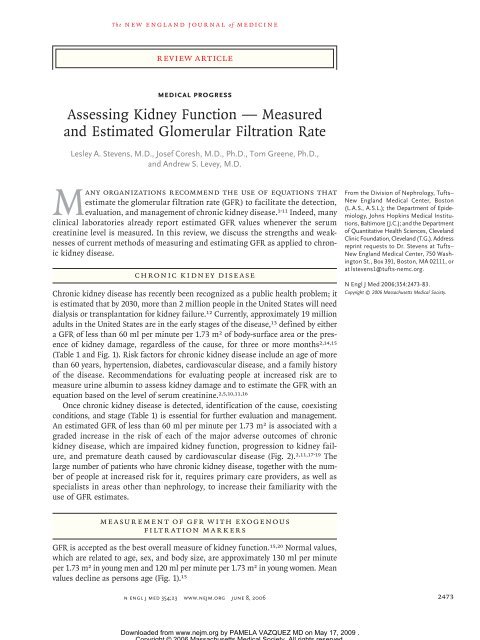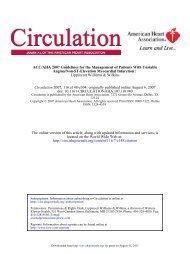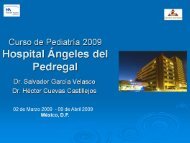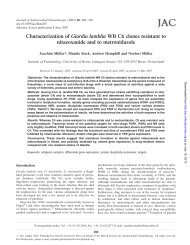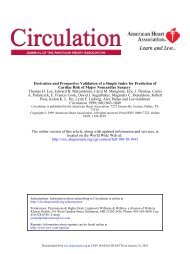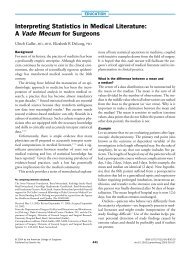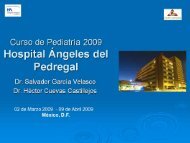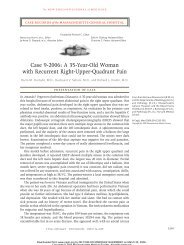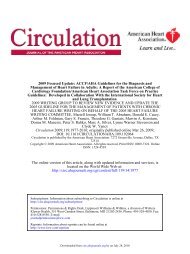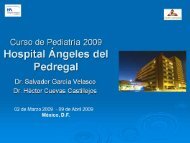Measured and Estimated Glomerular Filtration Rate
Measured and Estimated Glomerular Filtration Rate
Measured and Estimated Glomerular Filtration Rate
- No tags were found...
Create successful ePaper yourself
Turn your PDF publications into a flip-book with our unique Google optimized e-Paper software.
The new engl<strong>and</strong> journal of medicinereview articleMedical ProgressAssessing Kidney Function — <strong>Measured</strong><strong>and</strong> <strong>Estimated</strong> <strong>Glomerular</strong> <strong>Filtration</strong> <strong>Rate</strong>Lesley A. Stevens, M.D., Josef Coresh, M.D., Ph.D., Tom Greene, Ph.D.,<strong>and</strong> Andrew S. Levey, M.D.Many organizations recommend the use of equations thatestimate the glomerular filtration rate (GFR) to facilitate the detection,evaluation, <strong>and</strong> management of chronic kidney disease. 1-11 Indeed, manyclinical laboratories already report estimated GFR values whenever the serumcreatinine level is measured. In this review, we discuss the strengths <strong>and</strong> weaknessesof current methods of measuring <strong>and</strong> estimating GFR as applied to chronickidney disease.Chronic Kidney DiseaseChronic kidney disease has recently been recognized as a public health problem; itis estimated that by 2030, more than 2 million people in the United States will needdialysis or transplantation for kidney failure. 12 Currently, approximately 19 millionadults in the United States are in the early stages of the disease, 13 defined by eithera GFR of less than 60 ml per minute per 1.73 m 2 of body-surface area or the presenceof kidney damage, regardless of the cause, for three or more months 2,14,15(Table 1 <strong>and</strong> Fig. 1). Risk factors for chronic kidney disease include an age of morethan 60 years, hypertension, diabetes, cardiovascular disease, <strong>and</strong> a family historyof the disease. Recommendations for evaluating people at increased risk are tomeasure urine albumin to assess kidney damage <strong>and</strong> to estimate the GFR with anequation based on the level of serum creatinine. 2,5,10,11,16Once chronic kidney disease is detected, identification of the cause, coexistingconditions, <strong>and</strong> stage (Table 1) is essential for further evaluation <strong>and</strong> management.An estimated GFR of less than 60 ml per minute per 1.73 m 2 is associated with agraded increase in the risk of each of the major adverse outcomes of chronickidney disease, which are impaired kidney function, progression to kidney failure,<strong>and</strong> premature death caused by cardiovascular disease (Fig. 2). 2,11,17-19 Thelarge number of patients who have chronic kidney disease, together with the numberof people at increased risk for it, requires primary care providers, as well asspecialists in areas other than nephrology, to increase their familiarity with theuse of GFR estimates.From the Division of Nephrology, Tufts–New Engl<strong>and</strong> Medical Center, Boston(L.A.S., A.S.L.); the Department of Epidemiology,Johns Hopkins Medical Institutions,Baltimore (J.C.); <strong>and</strong> the Departmentof Quantitative Health Sciences, Clevel<strong>and</strong>Clinic Foundation, Clevel<strong>and</strong> (T.G.). Addressreprint requests to Dr. Stevens at Tufts–New Engl<strong>and</strong> Medical Center, 750 WashingtonSt., Box 391, Boston, MA 02111, orat lstevens1@tufts-nemc.org.N Engl J Med 2006;354:2473-83.Copyright © 2006 Massachusetts Medical Society.Measurement of GFR with Exogenous<strong>Filtration</strong> MarkersGFR is accepted as the best overall measure of kidney function. 15,20 Normal values,which are related to age, sex, <strong>and</strong> body size, are approximately 130 ml per minuteper 1.73 m 2 in young men <strong>and</strong> 120 ml per minute per 1.73 m 2 in young women. Meanvalues decline as persons age (Fig. 1). 15n engl j med 354;23 www.nejm.org june 8, 2006 2473Downloaded from www.nejm.org by PAMELA VAZQUEZ MD on May 17, 2009 .Copyright © 2006 Massachusetts Medical Society. All rights reserved.
The new engl<strong>and</strong> journal of medicineTable 1. Stages of Chronic Kidney Disease (CKD), Prevalence in the United States in 2000, <strong>and</strong> Stage-Specific Recommendationsfor Detection, Evaluation, <strong>and</strong> Management.Stageof CKD Description GFR1 Kidney damage withnormal or increasedGFR2 Kidney damage withmild decrease inGFR3 Moderate decrease inGFRml/min/1.73 m 2Detection, Evaluation,<strong>and</strong> Management*>90 Diagnosis <strong>and</strong> treatmentTreatment of coexisting conditionsSlowing progressionRisk reduction for cardiovascular diseasePrevalence†% No. of Cases (95% CI)millions2.8 5.6 (4.0–7.2)60–89 Estimation of progression 2.8 5.7 (4.2–7.2)30–59 Evaluation <strong>and</strong> treatment of complications 3.7 7.4 (6.0–8.9)4 Severe decrease in GFR 15–29 Referral to nephrologist <strong>and</strong> consideration forkidney replacement therapy0.1 0.30 (0.02–0.5)5 Kidney failure
medical progressA Men220200B Women220200Inulin Clearance (ml/min/1.73 m 2 )1801601401201008060Inulin Clearance (ml/min/1.73 m 2 )1801601401201008060404000 20 30 40 50 60 70 80 90Age (yr)00 20 30 40 50 60 70 80 90Age (yr)Figure 1. Normal Values for GFR in Men <strong>and</strong> Women.Normal values for inulin clearance are shown for men (Panel A) <strong>and</strong> women (Panel B) of various ages, with the GFRmeasured as the urinary clearance of inulin. A GFR value of 60 ml per minute per 1.73 m 2 is the threshold for thedefinition of chronic kidney disease. Solid lines represent the mean value of GFR per decade of age, <strong>and</strong> dashedlines represent the value 1 SD from the mean value of GFR per decade of age. Adapted from Wesson. 15clearance <strong>and</strong> elevating the serum creatinine levelwithout affecting the GFR. 28,29 The generation ofcreatinine is determined primarily by muscle mass<strong>and</strong> dietary intake (Table 2), which probably accountsfor the variations in the level of serumcreatinine observed among different age, geographic,ethnic, <strong>and</strong> racial groups. 28,30,31 Extrarenalelimination of creatinine may be increased atlow levels of GFR; this increase is mainly relatedto the degradation of creatinine by intestinal bacteria<strong>and</strong> can be affected by the use of antibiotics.26,27 For these reasons, the relationship betweenthe levels of serum creatinine <strong>and</strong> GFR varies substantiallyamong persons <strong>and</strong> over time. The useof a single reference range for serum creatinineto distinguish between a normal GFR <strong>and</strong> an abnormalone can be misleading (Fig. 3). 26-28,32,34Cystatin CCystatin C, a nonglycosylated basic protein witha low molecular mass (13 kD) that is freely filteredby the glomerulus, is currently under investigationas a replacement for serum creatinine in estimatingthe GFR. 35-40 After filtration, cystatin Cis reabsorbed <strong>and</strong> catabolized by the tubular epithelialcells; only small amounts are excreted inthe urine. Consequently, although cystatin C iscleared by the kidneys, its urinary clearance cannotbe measured, which makes the study of thefactors affecting its clearance <strong>and</strong> generation difficult.The generation of cystatin C appears to be lessvariable from person to person than that of creatinine.However, there is preliminary evidence thatserum levels of cystatin C are influenced by corticosteroiduse 41 <strong>and</strong> are related to age, sex, weight,height, smoking status, <strong>and</strong> the level of C-reactiveprotein, even after adjustment for creatinineclearance. 42 Other studies show extrarenal eliminationof the protein in the presence of highlevels of cystatin C. 36,37 Recent investigations suggestthat cystatin C may be a better filtrationmarker than creatinine, especially at higher levelsof GFR. However, it is less certain whether themeasurement of cystatin C is an improvementover creatinine-based equations for estimatingthe GFR. 35,36,43-45Equations Used to Estimate GFREstimating equations include variables such asage, sex, race, <strong>and</strong> body size, in addition to serumcreatinine, as surrogates for muscle mass, <strong>and</strong>therefore, they can overcome some of the limita-n engl j med 354;23 www.nejm.org june 8, 2006 2475Downloaded from www.nejm.org by PAMELA VAZQUEZ MD on May 17, 2009 .Copyright © 2006 Massachusetts Medical Society. All rights reserved.
The new engl<strong>and</strong> journal of medicinePercentage of Population9080706050403020100HypertensionUnable to walk 1/4 mileSerum calcium
medical progressto 0.9 ml per minute per 1.73 m 2 . 50-52,54 In somestudies, the MDRD study equation has been reportedto be more accurate than the Cockcroft–Gault equation, 50-52,54,71 whereas other studies havefound that the two yield similar results. 53,63,69,72The Cockcroft–Gault equation appears to be lessaccurate than the MDRD study equation in older<strong>and</strong> obese people. 54,69,71Both the MDRD study <strong>and</strong> the Cockcroft–Gaultequations have been reported to be less accuratein populations without chronic kidney disease,such as in young patients with type 1 diabeteswithout microalbuminuria <strong>and</strong> in potential kidneydonors. 50,52,54,56,57,63 On average, GFR estimatesof less than 90 ml per minute per 1.73 m 2in this population are lower than the directlymeasured values; mean differences between GFRestimates from the MDRD study equation <strong>and</strong>the direct GFR measurement range from –29 to3.3 ml per minute per 1.73 m 2 . 50,52,54,63,69 Thisdifference may lead to a false positive diagnosisof chronic kidney disease (a GFR of less than60 ml per minute per 1.73 m 2 ) in persons who donot have the disease but have a mild reductionin GFR. However, despite the potential misclassification,studies in the general population showthat an estimated GFR of less than 60 ml perminute per 1.73 m 2 is associated with an increasedrisk of adverse outcomes of chronic kidney disease.11,17,18,73There are several possible explanations forreports that higher GFR estimates may be inaccurate(see the Appendix). First, variation amonglaboratories in calibration of the serum creatinineassay has a larger effect at higher GFR levels <strong>and</strong>is probably an important reason for the widevariation in the results of published studies. 74-77Furthermore, the biologic <strong>and</strong> measurement variabilityof GFR is greater at higher levels. Finally,the use of an equation developed in a populationwith chronic kidney disease may be limited ina population without the disease.Use of GFR EstimatesGFR estimates appear to provide a substantial improvementover the measurement of serum creatininealone in the clinical assessment of kidneyfunction. However, proper interpretation of GFRestimates requires attention to their limitations.The following discussion focuses on the applicationof current estimating equations for selectedTable 2. Factors Affecting Creatinine Generation.*FactorAgingFemale sexRace or ethnic group†BlackHispanicAsianBody habitusMuscularAmputationObesityChronic illnessMalnutrition, inflammation, deconditioning(e.g., cancer, severe cardiovasculardisease, hospitalized patients)Neuromuscular diseasesDietVegetarian dietIngestion of cooked meataspects of the detection, evaluation, <strong>and</strong> managementof chronic kidney disease (Table 1).Detection of Chronic Kidney DiseaseA persistent reduction in the GFR to less than60 ml per minute per 1.73 m 2 is defined as chronickidney disease. 1,2,5 The differing accuracy of currentestimating equations in people with <strong>and</strong> thosewithout the disease may make it difficult to interpretGFR estimates that are near 60 ml per minuteper 1.73 m 2 . In this range, the interpretationof GFR estimates depends on the clinical context.Patients with markers of kidney damage such asproteinuria or abnormalities on imaging studiesor on kidney biopsy have the disease, even if GFRestimates are 60 ml per minute per 1.73 m 2 orgreater. Patients without markers of kidney damagewho have GFR estimates of 60 ml per minuteper 1.73 m 2 or greater are unlikely to have thedisease. There is some uncertainty with respectto patients without markers of kidney damage whohave GFR estimates just below 60 ml per minuteper 1.73 m 2 . Some of these patients may have ameasured GFR above 60 ml per minute per 1.73 m 2<strong>and</strong> therefore would not be considered to havechronic kidney disease. Clinical decision makingin these cases will depend on other characteris-Effect on Serum CreatinineDecreasedDecreasedIncreasedDecreasedDecreasedIncreasedDecreasedNo changeDecreasedDecreasedDecreasedIncreased* Variation in muscle mass accounts for the predominant proportion of creatininegeneration.† White race served as the reference group.n engl j med 354;23 www.nejm.org june 8, 2006 2477Downloaded from www.nejm.org by PAMELA VAZQUEZ MD on May 17, 2009 .Copyright © 2006 Massachusetts Medical Society. All rights reserved.
The new engl<strong>and</strong> journal of medicineAB10Men10WomenSerum Creatinine (mg/dl)8642, Black men, White menSerum Creatinine (mg/dl)8642, Black women, White women00 20 40 60 80 100 120GFR (ml/min/1.73 m 2 )00 20 40 60 80 100 120GFR (ml/min/1.73 m 2 )Figure 3. Relationship of Serum Creatinine Level to <strong>Measured</strong> GFR in the Modification of Diet in Renal Disease Study.GFR was measured as the urinary clearance of [ 125 I]iothalamate. Serum creatinine was measured with a BeckmanAstra CX3 analyzer <strong>and</strong> a kinetic alkaline picrate assay. 32,33 Regression lines were computed from the relationshipof the reciprocal of serum creatinine with GFR. When the GFR was 60 ml per minute per 1.73 m 2 , the 95 percent confidenceinterval for the serum creatinine level was 1.3 to 1.5 mg per deciliter in white men (measured in 802) <strong>and</strong> in 1.4to 1.8 in black men (measured in 113) (left panel) <strong>and</strong> 1.0 to 1.2 mg per deciliter in white women (measured in 502)<strong>and</strong> 1.1 to 1.4 mg per deciliter in black women (measured in 84) (right panel). These levels are close to the upper limitof the reference range. Confidence intervals for serum creatinine levels were wider at lower levels of GFR. To convertthe values for serum creatinine to micromoles per liter, multiply by 88.4. Adapted from Levey et al. 32tics of the patients, such as the presence or absenceof risk factors for the disease or its complications.Clinicians may decide to defer furtherevaluation in some patients, but it may be prudentto monitor their estimated GFR more frequently,adjust the dose of medications that are excretedby the kidney, <strong>and</strong> avoid medications toxic to thekidney.Monitoring Progression of Chronic KidneyDiseaseThe reciprocal relationship between GFR <strong>and</strong> serumcreatinine levels makes it difficult for cliniciansto appreciate the level <strong>and</strong> rate of change inGFR by simply monitoring serum creatinine levels.For example, in a 50-year-old white man anincrease in serum creatinine from 1.0 to 2.0 mgper deciliter (88.4 to 176.8 μmol per liter) reflectsa decline in GFR of 46 ml per minute per 1.73m 2 , but a further increase in the serum creatininelevel from 2.0 to 3.0 mg per deciliter (265.2 μmolper liter) reflects a further decline of only 14 mlper minute per 1.73 m 2 .Evaluation <strong>and</strong> Managementof ComplicationsDecreased kidney function is associated with manycomplications, such as hypertension, anemia, malnutrition,bone disease, <strong>and</strong> a decreased quality oflife (Fig. 2). 2 These complications can be treatedeffectively, especially if detected early. 78-81 Accordingly,testing for complications of this diseasehas been recommended beginning in patients withstage 3 chronic kidney disease (defined by a GFRof 30 to 59 ml per minute per 1.73 m 2 ). 2GFR <strong>and</strong> Referral to NephrologistsComplications related to chronic kidney disease<strong>and</strong> the risk of severe kidney failure are highestamong patients with stage 4 or 5 of the disease.11,17-19 Late referral to nephrologists beforethe initiation of dialysis is associated with increasedrates of morbidity <strong>and</strong> mortality. 82-84 Thus,it is important to refer any patient with a GFR estimatedto be less than 30 ml per minute per 1.73 m 2to a nephrologist for co-management.Medications <strong>and</strong> Chronic Kidney DiseaseMany medications are excreted by the kidneys <strong>and</strong>require adjustment in the dose when the GFR isreduced. The Cockcroft–Gault equation has beenwidely used in pharmacokinetic studies <strong>and</strong> in theguidance of drug dosing. In most cases, the GFRestimates from the MDRD study <strong>and</strong> the Cockcroft–Gault equations fall within the same interval fordose adjustment. Nonetheless, until there are more2478n engl j med 354;23 www.nejm.org june 8, 2006Downloaded from www.nejm.org by PAMELA VAZQUEZ MD on May 17, 2009 .Copyright © 2006 Massachusetts Medical Society. All rights reserved.
medical progressAB180180<strong>Measured</strong> GFR (ml/min/1.73 m 2 )150120906030<strong>Measured</strong> GFR (ml/min/1.73 m 2 )150120906030000 30 60 90 120 150 1800 30 60 90 120 150 180GFR <strong>Estimated</strong> with 4-Variable MDRD StudyEquation (ml/min/1.73 m 2 )GFR <strong>Estimated</strong> with Cockcroft–Gault StudyEquation (ml/min/1.73 m 2 )Figure 4. Relation of <strong>Estimated</strong> GFR to <strong>Measured</strong> GFR in the Participants in the Modification of Diet in RenalDisease (MDRD) Study.The GFR was measured in 1628 patients as the urinary clearance of [ 125 I]iothalamate <strong>and</strong> adjusted for body-surfacearea. The estimated GFR is expressed with the use of the MDRD study equation (R 2 =0.88) (left panel) <strong>and</strong> theCockcroft–Gault equation (R 2 =0.83) (right panel). Each point represents the baseline measurement. The solid diagonalline represents the line of identity. The bold dashed line represents the fitted line with smoothing-splines functionplotted from the 2.5 to the 97.5 percentile of estimated GFR. Thin dashed lines represent the difference of ±30percent between estimated <strong>and</strong> measured GFR. 33,47data based on the MDRD study equation or othernew equations, physicians <strong>and</strong> pharmacists maychoose to continue to use the Cockcroft–Gaultequation to adjust drug doses in patients with adecreased estimated GFR. The appropriate adjustmentin medication dose for patients who are eithervery large or very small in size requires theexpression of GFR estimates in milliliters perminute, rather than in milliliters per minute per1.73 m 2 . 49Assessment of Risk for Cardiovascular DiseaseAn estimated GFR below 60 ml per minute per1.73 m 2 is a risk factor for both new <strong>and</strong> recurrentcardiovascular disease in the general population<strong>and</strong> in people at increased risk for cardiovasculardisease. 11,17-19 In these patients, deathfrom cardiovascular disease is more common thanprogression to kidney failure. 73 Patients with anestimated GFR below 60 ml per minute per 1.73m 2 are therefore considered to be in the high-riskgroup for cardiovascular disease, <strong>and</strong> they shouldundergo intensive evaluation <strong>and</strong> treatment ofrisk factors for cardiovascular disease. 1,11Recent studies suggest that the serum levelof cystatin C may be a better predictor of outcomesof cardiovascular disease than GFR estimatesbased on levels of serum creatinine. It isnot known whether the prediction is improvedbecause cystatin C is a better marker of GFR thanlevels of serum creatinine or because factorsapart from GFR that affect the level of cystatinC or creatinine also are related to the risk ofcardiovascular disease. 35-45,85-87 For example,many chronic diseases, including cardiovasculardisease, are associated with decreased musclemass <strong>and</strong>, consequently, lower serum creatininelevels <strong>and</strong> higher estimated GFR, whichwould weaken the association of lower estimatedGFR <strong>and</strong> cardiovascular disease. Factors relatedto higher levels of cystatin C are less well understood,but a reported positive association withC-reactive protein would strengthen the associationof a higher level of cystatin C <strong>and</strong> cardiovasculardisease.When to Consider Clearance Measurements Insteadof <strong>Estimated</strong> GFRGFR estimates are less accurate in certain circumstances.One such circumstance occurs in peoplewith unusual body habitus or diet (Table 2); forexample, a person with substantial muscle wast-n engl j med 354;23 www.nejm.org june 8, 2006 2479Downloaded from www.nejm.org by PAMELA VAZQUEZ MD on May 17, 2009 .Copyright © 2006 Massachusetts Medical Society. All rights reserved.
The new engl<strong>and</strong> journal of medicineing may have a lower GFR than suggested by theGFR estimate, even at GFR levels of less than 60ml per minute per 1.73 m 2 , owing to a low levelof creatinine generation. Another circumstanceis in patients with rapidly changing kidney function;in these patients, changes in GFR estimateslag behind changes in measured GFR. GFR can beestimated from the rate <strong>and</strong> magnitude of changein the GFR estimate, analogous to the interpretationof changes in the serum creatinine level inthe nonsteady state. The third circumstance involvespatients with GFR estimates of 60 ml perminute per 1.73 m 2 or greater. More accurate estimatesmay be necessary to evaluate people forkidney donation, administer drugs with markedtoxic effects <strong>and</strong> that are excreted by the kidneys(e.g., high-dose methotrexate), or determine aperson’s eligibility for research protocols.Clearance of exogenous filtration markers providesthe most accurate measure of GFR <strong>and</strong>could be used if facilities for administration ofthe marker <strong>and</strong> its measurement are available.Creatinine clearance can be measured from a24-hour urine collection <strong>and</strong> a single serum samplein the steady state, but the results must beinterpreted with caution because of errors in collectionof timed urine specimens <strong>and</strong> becausecreatinine clearance exceeds GFR. The formersource of error might be reduced by repeated measurements<strong>and</strong> the latter by pretreatment withcimetidine, which partially inhibits creatinine secretion.88 If cystatin C is shown to be a better endogenousmarker of GFR, estimation of GFR fromcystatin C might be helpful in some of these circumstances.GFR Reporting by Clinical LaboratoriesReporting the estimated GFR may improve physicians’recognition of chronic kidney disease. 89Current recommendations to clinical laboratoriestake into account the greater inaccuracy of GFRestimates at higher levels. 4 Laboratories should reporta specific value of GFR only if the estimatedGFR is less than 60 ml per minute per 1.73 m 2 ;higher values should be reported as “GFR is 60 mlper minute per 1.73 m 2 or more.”ConclusionsThe main limitation of current GFR estimates isthe greater inaccuracy in populations withoutknown chronic kidney disease than in those withthe disease. Nonetheless, current GFR estimatesfacilitate detection, evaluation, <strong>and</strong> managementof the disease, <strong>and</strong> they should result in improvedpatient care <strong>and</strong> better clinical outcomes. The reportingof estimated GFR whenever the measurementof serum creatinine is ordered should becoordinated with a campaign to educate physicians,health care organizations, patients, <strong>and</strong> thepublic about chronic kidney disease <strong>and</strong> the interpretationof GFR estimates.Supported by grants from the National Institutes of Health(UO1 DK 053869, to Dr. Levey, <strong>and</strong> UO1 DK 067651 <strong>and</strong>1R21DK67651, to Dr. Coresh).Dr. Stevens reports having received lecture fees from QuestDiagnostics. Dr. Levey reports having received grant supportfrom the National Institutes of Health, Amgen, the NationalKidney Foundation, <strong>and</strong> the American College of Physicians.No other potential conflict of interest relevant to this articlewas reported.We are indebted to the coinvestigators of the Chronic KidneyDisease Epidemiology Collaboration — Christopher H. Schmid,Ph.D., Harold I. Feldman, M.D., M.S.C.E., J. Richard L<strong>and</strong>is, Ph.D.,Frederick VanLente, Ph.D., John W. Kusek, Ph.D., Paul Eggers,Ph.D., <strong>and</strong> Thomas H. Hostetter, M.D. — for their contributionsto this article; <strong>and</strong> to Amy Deysher for editorial assistance.APPENDIXMeasuring CreatinineThe alkaline picrate assay is subject to interference by noncreatininechromogens, causing an overestimation of serum creatininein normal persons of up to 20 percent. 90 Noncreatinine chromogensare not retained at a reduced GFR; hence, their relative effectis greater at the lower range of levels of serum creatinine. Enzymaticassays do not detect noncreatinine chromogens <strong>and</strong> yieldlower values for serum creatinine. Calibration of serum creatinineassays to adjust for these differences is not st<strong>and</strong>ardized acrosslaboratories, leading to substantial variation in reported valuesamong laboratories. 90Measuring Cystatin CCurrently, the particle-enhanced nephelometric immunoassay(PENIA) developed for the Dade Behring nephelometers is themost frequently used assay for cystatin C. 40 Studies show variationamong assays, <strong>and</strong> as cystatin C becomes more widely adopted,more assays are likely to become available.Inaccurate Performance of gfr estimatingequations in Populations without ChronicKidney DiseaseCreatinine CalibrationIn a chemistry survey of 5624 clinical laboratories in 2003 by theCollege of American Pathologists, the peer-group mean bias forserum creatinine ranged from −0.06 to 0.31 mg per deciliter (−5.25to 27.4 μmol per liter) for a specimen with an assigned value of0.902 mg per deciliter (79.7 μmol per liter), with 60 percent of thelaboratory peer groups having significant bias (P
medical progressMeasurement Error <strong>and</strong> Biologic Variation in GFRReported differences between the estimated <strong>and</strong> measured GFRreflect, in part, measurement error in the GFR <strong>and</strong> the normalbiologic variation in the GFR, both of which are greater at higherGFR levels. Thus, reported differences would tend to overstate themagnitude of the differences between the estimated <strong>and</strong> true GFR,especially at higher GFR levels when reported on the raw scalerather than as a percent. Such differences represent a limitation ofGFR measurement, rather than of estimating equations as such.Limitations of Generalizing Equations Developedin Populations with Chronic Kidney DiseaseSurrogates for Creatinine GenerationPatients with chronic kidney disease may have lower muscle mass<strong>and</strong> dietary protein intake than healthy people. Thus, the relationshipsobserved in the populations that were included in the MDRD <strong>and</strong>Cockcroft–Gault studies may differ from those observed in healthypeople, leading to increased errors when estimation equations derivedin populations with the disease are applied to healthy people.Determinants of Variation in Serum CreatinineThe proportional variation in the GFR is larger in populations withthe disease (by a factor of approximately 10, from 6 to 60 ml perminute per 1.73 m 2 ) than in populations without the disease (by afactor of approximately 3, from 60 to 180 ml per minute per 1.73 m 2 ).As a result, a larger proportion of the variation in serum creatininelevels among patients with the disease is due to a variation in theGFR, not to a variation in the other determinants as compared withhealthy people. For example, among patients with the disease, a differencein levels of serum creatinine of 0.8 <strong>and</strong> 1.2 mg per deciliter(70.7 <strong>and</strong> 106.1 μmol per liter) probably reflects a difference in theGFR. In contrast, this same difference among healthy people morelikely reflects a difference in muscle mass or protein intake, ratherthan the GFR. When an estimating equation derived in a populationwith chronic kidney disease is applied to a healthy population, theequation will overstate the strength of the relationship of the GFRwith the level of serum creatinine. Thus, in people with an unusuallylow or high estimated GFR, the measured GFR would tendto fall closer to the normal GFR of the population than the GFRestimates.Mean Level of GFRGFR estimates derived through a regression equation will deviatesystematically toward the mean of the study population in whichthe equation was derived (i.e., the phenomenon of regression tothe mean). Thus, the mean level of the GFR in healthy people bycurrent estimating equations would be slightly lower than the meanof measured GFR. However, regression to the mean is smaller forestimating equations derived in populations in which the regressionmodel exhibits a high squared correlation (90.3 percent for theMDRD study equation) than it would be for equations derived inpopulations with lower correlations, as are typically found in thedevelopment of equations with a higher or narrower GFR range.Creatinine St<strong>and</strong>ardizationThe National Kidney Education Program has initiated a creatininest<strong>and</strong>ardization program to minimize this variation, 34 analogousto the st<strong>and</strong>ardization of lipid measurements as the first step ofthe National Cholesterol Education Program in the 1980s. Theresults are not expected to be completed until 2008. Until the st<strong>and</strong>ardizationprogram is complete, GFR estimates should be computedwith the use of the original four-variable MDRD study equationdeveloped in 1999. After st<strong>and</strong>ardization is accomplished, estimatescomputed with the MDRD study equation reexpressed in2005 will be reasonable. 47New Equations to Estimate GFRThe National Institute of Diabetes <strong>and</strong> Digestive <strong>and</strong> Kidney Diseaseshas funded a research group, Chronic Kidney Disease EpidemiologyCollaboration, to develop improved estimating equationsfor GFR. The group will develop equations from large pooled databasesof subjects with formal measurements of GFR, st<strong>and</strong>ardizedserum creatinine, <strong>and</strong> cystatin C. New equations will be validatedin independent populations to evaluate generalizability. Theeffect of errors in performance of the equations related to differencesin the creatinine assay, GFR-measurement techniques, <strong>and</strong>population characteristics will be quantified.References1. Levey AS, Coresh J, Balk E, et al. NationalKidney Foundation practice guidelinesfor chronic kidney disease: evaluation,classification, <strong>and</strong> stratification. AnnIntern Med 2003;139:137-47. [Erratum, AnnIntern Med 2003;139:605.]2. National Kidney Foundation. K/DOQIclinical practice guidelines for chronic kidneydisease: evaluation, classification, <strong>and</strong>stratification. Am J Kidney Dis 2002;39:Suppl 1:S1-S266.3. Siegel NJ. Renal Express (online journalof the American Society of Nephrology).October 2003. (Accessed May 15, 2006,at http://www.asn-online.org/newsletter/renal_express/2003/03-10_Rxpress.aspx.)4. National Kidney Disease EducationProgram. Laboratory professionals: CreatinineSt<strong>and</strong>ardization Program. (AccessedMay 15, 2006, at http://www.nkdep.nih.gov/labprofessionals/index.htm.)5. Levey AS, Eckardt KU, Tsukamoto Y,et al. Definition <strong>and</strong> classification of chronickidney disease: a position statement fromKidney Disease: Improving Global Outcomes(KDIGO). Kidney Int 2005;67:2089-100.6. State of New Jersey, 211th Legislature.Senate bill no. 2232. January 24, 2005. (AccessedMay 15, 2006, at http://www.njleg.state.nj.us/2004/Bills/S2500/2232_I1.pdf.)7. Mathew TH, Australasian CreatinineConsensus Working Group. Chronic kidneydisease <strong>and</strong> automatic reporting of estimatedglomerular filtration rate: a positionstatement. Med J Aust 2005;183:138-41.8. La Caisse nationale d’assurance maladiedes professions indépendantes: avenantà la convention nationale des directeurs delaboratoire privé d’analyses médicales. (AccessedMay 15, 2006, at http://www.admi.net/jo/20030227/SANS0320604X.html.)9. British Columbia Ministry of Health,Guidelines & Protocols Advisory Committee.Identification, evaluation <strong>and</strong> managementof patients with chronic kidney disease.(Accessed May 15, 2006, at http://www.healthservices.gov.bc.ca/msp/protoguides/gps/ckd.pdf.)10. Chobanian AV, Bakris GL, Black HR,et al. The Seventh Report of the Joint NationalCommittee on Prevention, Detection,Evaluation, <strong>and</strong> Treatment of HighBlood Pressure: the JNC 7 report. JAMA2003;289:2560-72. [Erratum, JAMA 2003;290:197.]11. Sarnak MJ, Levey AS, Schoolwerth AC,et al. Kidney disease as a risk factor fordevelopment of cardiovascular disease:a statement from the American Heart AssociationCouncils on Kidney in CardiovascularDisease, High Blood Pressure Research,Clinical Cardiology, <strong>and</strong> Epidemiology <strong>and</strong>Prevention. Hypertension 2003;42:1050-65.12. Renal Data System. 2005 Annual datareport: atlas of end-stage renal disease inthe United States. Bethesda, Md.: NationalInstitute of Diabetes <strong>and</strong> Digestive <strong>and</strong>Kidney Diseases, 2005.13. Coresh J, Byrd-Holt D, Astor BC, et al.Chronic kidney disease awareness, prevalence,<strong>and</strong> trends among U.S. adults, 1999to 2000. J Am Soc Nephrol 2005;16:180-8.14. Renal Data System. 2001 Annual datareport: atlas of end-stage renal disease inthe United States. Bethesda, Md.: NationalInstitute of Diabetes <strong>and</strong> Digestive <strong>and</strong>Kidney Diseases, 2001.15. Wesson L. Physiology of the humann engl j med 354;23 www.nejm.org june 8, 2006 2481Downloaded from www.nejm.org by PAMELA VAZQUEZ MD on May 17, 2009 .Copyright © 2006 Massachusetts Medical Society. All rights reserved.
The new engl<strong>and</strong> journal of medicinekidney. New York: Grune & Stratton, 1969.16. Brosius FC III, Hostetter TH, KelepourisE, et al. AHA science advisory ondetection of kidney disease in patientswith or at increased risk of cardiovasculardisease. Circulation (in press).17. Go A, Chertow G, Fan D, McCullochCE, Hsu CY. Chronic kidney disease <strong>and</strong>the risks of death, cardiovascular events,<strong>and</strong> hospitalization. N Engl J Med 2004;351:1296-305.18. Weiner DE, Tighiouart H, Amin MG,et al. Chronic kidney disease as a risk factorfor cardiovascular disease <strong>and</strong> allcausemortality: a pooled analysis of community-basedstudies. J Am Soc Nephrol2004;15:1307-15.19. Coresh J, Astor B, Sarnak M. Evidencefor increased cardiovascular disease riskin patients with chronic kidney disease.Curr Opin Nephrol Hypertens 2004;13:73-81.20. Smith H. Comparative physiology ofthe kidney. In: Smith H, ed. The kidney:structure <strong>and</strong> function in health <strong>and</strong> disease.New York: Oxford University Press,1951:520-74.21. Mohanram A, Toto R. Measurementof kidney function. In: Pereira BJG, SayeghMH, Blake PG, eds. Chronic kidney disease,dialysis, <strong>and</strong> transplantation: a companionto Brenner <strong>and</strong> Rector’s The Kidney.Philadelphia: Saunders, 2005:20-30.22. Levey AS, Greene T, Schluchter MD, etal. <strong>Glomerular</strong> filtration rate measurementsin clinical trials: Modification ofDiet in Renal Disease Study Group <strong>and</strong>the Diabetes Control <strong>and</strong> ComplicationsTrial Research Group. J Am Soc Nephrol1993;4:1159-71.23. Coresh J, Toto RD, Kirk KA, et al. Creatinineclearance as a measure of GFR inscreenees for the African-American Studyof Kidney Disease <strong>and</strong> Hypertension pilotstudy. Am J Kidney Dis 1998;32:32-42.24. Perrone RD, Steinman TI, Beck GJ, etal. Utility of radioisotopic filtration markersin chronic renal insufficiency: simultaneouscomparison of 125I-iothalamate,169Yb-DTPA, 99mTc-DTPA, <strong>and</strong> inulin.Am J Kidney Dis 1990;16:224-35.25. Gaspari F, Perico N, Matalone M, etal. Precision of plasma clearance of iohexolfor estimation of GFR in patientswith renal disease. J Am Soc Nephrol 1998;9:310-3.26. Shemesh O, Golbetz H, Kriss JP, MyersBD. Limitations of creatinine as a filtrationmarker in glomerulopathic patients.Kidney Int 1985;28:830-8.27. Stevens LA, Levey AS. Measurement ofkidney function. Med Clin North Am 2005;89:457-73.28. Levey AS. Measurement of renal functionin chronic renal disease. Kidney Int1990;38:167-84.29. Berglund F, Kill<strong>and</strong>er J, Pompeius R.Effect of trimethoprim-sulfamethoxazoleon the renal excretion of creatinine in man.J Urol 1975;114:802-8.30. Jones CA, McQuillan GM, Kusek JW,et al. Serum creatinine levels in the USpopulation: Third National Health <strong>and</strong>Nutrition Examination Survey. Am J KidneyDis 1998;32:992-9. [Erratum, Am J KidneyDis 2000;35:178.]31. Jafar TH, Chaturvedi N, Gul A, KhanAQ, Schmid CH, Levey AS. Ethnic differences<strong>and</strong> determinants of proteinuriaamong South Asian subgroups in Pakistan.Kidney Int 2603;64:1437-44.32. Levey AS, Bosch JP, Lewis JB, GreeneT, Rogers N, Roth D. A more accuratemethod to estimate glomerular filtrationrate from serum creatinine: a new predictionequation. Ann Intern Med 1999;130:461-70.33. Levey AS, Greene T, Kusek J, Beck G.A simplified equation to predict glomerularfiltration rate from serum creatinine.J Am Soc Nephrol 2000;11:155A. abstract.34. Myers GL, Miller WG, Coresh J, et al.Recommendations for improving serumcreatinine measurement: a report fromthe Laboratory Working Group of the NationalKidney Disease Education Program.Clin Chem 2006;52:5-18.35. Dharnidharka VR, Kwon C, StevensG. Serum cystatin C is superior to serumcreatinine as a marker of kidney function:a meta-analysis. Am J Kidney Dis 2002;40:221-6.36. Grubb AO. Cystatin C — properties<strong>and</strong> use as diagnostic marker. Adv ClinChem 2000;35:63-99.37. Sjostrom P, Tidman M, Jones I. Determinationof the production rate <strong>and</strong> nonrenalclearance of cystatin C <strong>and</strong> estimationof the glomerular filtration rate fromthe serum concentration of cystatin C inhumans. Sc<strong>and</strong> J Clin Lab Invest 2005;65:111-24.38. Keevil BG, Kilpatrick ES, Nichols SP,Maylor PW. Biological variation of cystatinC: implications for the assessmentof glomerular filtration rate. Clin Chem1998;44:1535-9.39. Nilsson-Ehle P, Dahlbeck M-L, MiljeteigL, Rauer O, Resma M. Biological variationof cystatin C concentration in serum.Sc<strong>and</strong> J Clin Lab Invest 1996;56:16. abstract.40. Finney H, Newman DJ, Gruber W,Merle P, Price CP. Initial evaluation of cystatinC measurement by particle-enhancedimmunonephelometry on the Behringnephelometer systems (BNA, BN II). ClinChem 1997;43:1016-22.41. Bokenkamp A, Domanetzki M, ZinckR, Schumann G, Byrd D, Brodehl J. CystatinC serum concentrations underestimateglomerular filtration rate in renaltransplant patients. Clin Chem 1999;45:1866-8.42. Knight EL, Verhave JC, Spiegelman D,et al. Factors influencing serum cystatinC levels other than renal function <strong>and</strong> theimpact on renal function measurement.Kidney Int 2004;65:1416-21.43. Laterza OF, Price CP, Scott MG. CystatinC: an improved estimator of glomerularfiltration rate? Clin Chem 2002;48:699-707.44. Grubb A, Nyman U, Bjork J, et al.Simple cystatin C-based prediction equationsfor glomerular filtration rate comparedwith the Modification of Diet in RenalDisease prediction equation for adults<strong>and</strong> the Schwartz <strong>and</strong> the Counahan-Barrattprediction equations for children. ClinChem 2005;51:1420-31.45. Filler G, Lepage N. Should the Schwartzformula for estimation of GFR be replacedby cystatin C formula? Pediatr Nephrol2003;18:981-5.46. Cockcroft DW, Gault MH. Predictionof creatinine clearance from serum creatinine.Nephron 1976;16:31-41.47. Levey AS, Coresh J, Greene T, et al.Expressing the MDRD study equation forestimating GFR with IDMS traceable (goldst<strong>and</strong>ard) serum creatinine values. J AmSoc Nephrol 2005;16:69A. abstract.48. Sokoll LJ, Russell RM, Sadowski JA,Morrow FD. Establishment of creatinineclearance reference values for older women.Clin Chem 1994;40:2276-81.49. Stevens LA, Levey AS. Frequently askedquestions about GFR estimates. NewYork: National Kidney Foundation, 2004.(Accessed May 15, 2006, at http://www.kidney.org/professionals/kls/pdf/faq_gfr.pdf.)50. Poggio ED, Wang X, Greene T, VanLente F, Hall PM. Performance of theModification of Diet in Renal Disease <strong>and</strong>Cockcroft-Gault equations in the estimationof GFR in health <strong>and</strong> in chronic kidneydisease. J Am Soc Nephrol 2005;16:459-66.51. Lewis J, Agodoa L, Cheek D, et al.Comparison of cross-sectional renal functionmeasurements in African Americanswith hypertensive nephrosclerosis <strong>and</strong> ofprimary formulas to estimate glomerularfiltration rate. Am J Kidney Dis 2001;38:744-53. [Erratum, Am J Kidney Dis 2002;39:444.]52. Rule AD, Larson TS, Bergstralh EJ,Slezak JM, Jacobsen SJ, Cosio FG. Usingserum creatinine to estimate glomerularfiltration rate: accuracy in good health<strong>and</strong> in chronic kidney disease. Ann InternMed 2004;141:929-37.53. Gonwa TA, Jennings L, Mai ML, StarkPC, Levey AS, Klintmalm GB. Estimationof glomerular filtration rates before <strong>and</strong>after orthotopic liver transplantation: evaluationof current equations. Liver Transpl2004;10:301-9.54. Froissart M, Rossert J, Jacquot C, PaillardM, Houillier P. Predictive performanceof the Modification of Diet in RenalDisease <strong>and</strong> Cockcroft-Gault equations2482n engl j med 354;23 www.nejm.org june 8, 2006Downloaded from www.nejm.org by PAMELA VAZQUEZ MD on May 17, 2009 .Copyright © 2006 Massachusetts Medical Society. All rights reserved.
medical progressfor estimating renal function. J Am SocNephrol 2005;16:763-73.55. Hallan S, Asberg A, Lindberg M, JohnsenH. Validation of the Modification ofDiet in Renal Disease formula for estimatingGFR with special emphasis oncalibration of the serum creatinine assay.Am J Kidney Dis 2004;44:84-93.56. Lin J, Knight E, Hogan ML, Singh AK.A comparison of prediction equations forestimating glomerular filtration rate inadults without kidney disease. J Am SocNephrol 2003;14:2573-80. [Erratum, J AmSoc Nephrol 2005;16:2814.]57. Bostom AG, Kronenberg F, Ritz E.Predictive performance of renal functionequations for patients with chronic kidneydisease <strong>and</strong> normal serum creatininelevels. J Am Soc Nephrol 2002;13:2140-4.58. Zuo L, Ma YC, Zhou YH, Wang M, XuGB, Wang HY. Application of GFR-estimatingequations in Chinese patients withchronic kidney disease. Am J Kidney Dis2005;45:463-72.59. Gaspari F, Ferrari S, Stucchi N, et al.Performance of different prediction equationsfor estimating renal function in kidneytransplantation. Am J Transplant 2004;4:1826-35.60. Lamb EJ, Webb MC, Simpson DE, CoakleyAJ, Newman DJ, O’Riordan SE. Estimationof glomerular filtration rate in olderpatients with chronic renal insufficiency:is the Modification of Diet in Renal Diseaseformula an improvement? J Am GeriatrSoc 2003;51:1012-7.61. Vervoort G, Willems HL, Wetzels JF.Assessment of glomerular filtration ratein healthy subjects <strong>and</strong> normoalbuminuricdiabetic patients: validity of a new(MDRD) prediction equation. Nephrol DialTransplant 2002;17:1909-13.62. Skluzacek PA, Szewc RG, Nolan CRIII, Riley DJ, Lee S, Pergola PE. Predictionof GFR in liver transplant c<strong>and</strong>idates. AmJ Kidney Dis 2003;42:1169-76.63. Ibrahim H, Mondress M, Tello A, FanY, Koopmeiners J, Thomas W. An alternativeformula to the Cockcroft-Gault <strong>and</strong>the Modification of Diet in Renal Diseaseformulas in predicting GFR in individualswith type 1 diabetes. J Am Soc Nephrol2005;16:1051-60.64. Rigalleau V, Lasseur C, Perlemoine C,et al. Estimation of glomerular filtrationrate in diabetic subjects: Cockcroft formulaor Modification of Diet in Renal Diseasestudy equation? Diabetes Care 2005;28:838-43.65. Poge U, Gerhardt T, Palmedo H, KlehrH-U, Sauerbruch T, Woitas RP. MDRDequations for estimation of GFR in renaltransplant recipients. Am J Transplant 2005;5:1306-11.66. Grubb A, Bjork J, Lindstrom V, SternerG, Bondesson P, Nyman U. A cystatinC-based formula without anthropometricvariables estimates glomerular filtrationrate better than creatinine clearance usingthe Cockcroft-Gault formula. Sc<strong>and</strong>J Clin Lab Invest 2005;65:153-62.67. Fehrman-Ekholm I, Skeppholm L. Renalfunction in the elderly (>70 years old)measured by means of iohexol clearance,serum creatinine, serum urea <strong>and</strong> estimatedclearance. Sc<strong>and</strong> J Urol Nephrol 2004;38:73-7.68. Poggio ED, Nef PC, Wang X, et al. Performanceof the Cockcroft-Gault <strong>and</strong> Modificationof Diet in Renal Disease equationsin estimating GFR in ill hospitalizedpatients. Am J Kidney Dis 2005;46:242-52.69. Verhave JC, Fesler P, Ribstein J, duCailar G, Mimran A. Estimation of renalfunction in subjects with normal serumcreatinine levels: influence of age <strong>and</strong>body mass index. Am J Kidney Dis 2005;46:233-41.70. Coresh J, Stevens LA. Kidney functionestimating equations: where do we st<strong>and</strong>?Curr Opin Nephrol Hypertens 2006;15:276-84.71. Cirillo M, Anastasio P, De Santo NG.Relationship of gender, age, <strong>and</strong> body massindex to errors in predicted kidney function.Nephrol Dial Transplant 2005;20:1791-8.72. Rule AD, Gussak HM, Pond GR, et al.<strong>Measured</strong> <strong>and</strong> estimated GFR in healthypotential kidney donors. Am J Kidney Dis2004;43:112-9. [Errata, Am J Kidney Dis2004;44:1126, 2005;46:170.]73. Keith DS, Nichols GA, Guillion CM,Brown JB, Smith DH. Longitudinal followup<strong>and</strong> outcomes among a populationwith chronic kidney disease in a largemanaged care organization. Arch InternMed 2004;164:659-63.74. Clase C, Garg A, Kiberd B. Estimatingthe prevalence of low glomerular filtrationrate requires attention to the creatininecalibration assay. J Am Soc Nephrol2002;13:1338-49.75. Coresh J, Eknoyan G, Levey AS. Estimatingthe prevalence of low glomerularfiltration rate requires attention to thecreatinine assay calibration. J Am SocNephrol 2002;13:2811-2.76. Coresh J, Astor BC, McQuillan G, etal. Calibration <strong>and</strong> r<strong>and</strong>om variation ofthe serum creatinine assay as critical elementsof using equations to estimate theglomerular filtration rate. Am J KidneyDis 2002;39:920-9.77. Murthy K, Stevens LA, Stark PC, LeveyAS. Variation in serum creatinine assaycalibration: a practical application to glomerularfiltration rate estimation. KidneyInt 2005;68:1884-7.78. National Kidney Foundation. Clinicalpractice guidelines on hypertension <strong>and</strong>antihypertensive agents in chronic kidneydisease. Am J Kidney Dis 2004;43:Suppl 1:S1-S290.79. Cameron JS. European best practiceguidelines for the management of anemiain patients with chronic renal failure.Nephrol Dial Transplant 1999;14:Suppl 2:61-5.80. National Kidney Foundation. Clinicalpractice guidelines for nutrition in chronicrenal failure. Am J Kidney Dis 2000;35:Suppl 2:S56-S64.81. Idem. Clinical practice guidelines forbone metabolism <strong>and</strong> disease in chronickidney disease. Am J Kidney Dis 2004;42:Suppl 3:S1-S202.82. Kinchen KS, Sadler J, Fink N, et al. Thetiming of specialist evaluation in chronickidney disease <strong>and</strong> mortality. Ann InternMed 2002;137:479-86.83. Obrador GT, Pereira BJG. Early referralto the nephrologist <strong>and</strong> timely initiationof renal replacement therapy: a paradigmshift in the management of patientswith chronic renal failure. Am J KidneyDis 1998;31:398-417.84. Obrador GT, Ruthazer R, Arora P, KauszA, Pereira BJG. Prevalence of <strong>and</strong> factorsassociated with suboptimal care prior toinitiation of dialysis in the United States.J Am Soc Nephrol 1999;10:1793-800.85. Shlipak MG, Sarnak MJ, Katz R, et al.Cystatin C <strong>and</strong> the risk of death <strong>and</strong> cardiovascularevents among elderly persons.N Engl J Med 2005;352:2049-60.86. Stevens LA, Levey AS. Chronic kidneydisease in the elderly — how to assessrisk. N Engl J Med 2005;352:2122-4.87. Sarnak MJ, Katz R, Stehman-BreenCO, et al. Cystatin C concentration as arisk factor for heart failure in older adults.Ann Intern Med 2005;142:497-505.88. Roubenoff R, Drew H, Moyer M, PetriM, Whiting-O’Keefe Q, Hellmann DB. Oralcimetidine improves the accuracy <strong>and</strong> precisionof creatinine clearance in lupus nephritis.Ann Intern Med 1990;113:501-6.89. Akbari A, Swedko PJ, Clark HD, et al.Detection of chronic kidney disease withlaboratory reporting of estimated glomerularfiltration rate <strong>and</strong> an educational program.Arch Intern Med 2004;164:1788-92.90. Miller WG, Myers GL, Ashwood ER, etal. Creatinine measurement: state of theart in accuracy <strong>and</strong> interlaboratory harmonization.Arch Pathol Lab Med 2005;129:297-304.91. Ross JW, Miller WG, Myers GL,Praestgaard J. The accuracy of laboratorymeasurements in clinical chemistry: a studyof 11 routine chemistry analytes in the Collegeof American Pathologists ChemistrySurvey with fresh frozen serum, definitivemethods, <strong>and</strong> reference methods. ArchPathol Lab Med 1998;122:587-608.Copyright © 2006 Massachusetts Medical Society.n engl j med 354;23 www.nejm.org june 8, 2006 2483Downloaded from www.nejm.org by PAMELA VAZQUEZ MD on May 17, 2009 .Copyright © 2006 Massachusetts Medical Society. All rights reserved.


